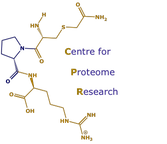Asymetric equalisation with combinatorial beads
Jenny Rivers, Chris Hughes, Thérèse McKenna, Yvonne Woolerton, Johannes P. C. Vissers, James I. Langridge and Robert J. Beynon (2011) Asymmetric proteome equalization of the skeletal muscle proteome using a combinatorial hexapeptide library PLOS One (in press)
Immobilized combinatorial peptide libraries have been advocated as a strategy for equalization of the dynamic range of a typical proteome. The technology has been applied predominantly to blood plasma and other biological fluids such as urine, but has not been used extensively to address the issue of dynamic range in tissue samples. Here, we have applied the combinatorial library approach to the equalization of a tissue where there is also a dramatic asymmetry in the range of abundances of proteins; namely, the soluble fraction of skeletal muscle. We have applied QconCAT and label-free methodology to the quantification of the proteins that bind to the beads as the loading is progressively increased. Although some equalization is achieved, and the most abundant proteins no longer dominate the proteome analysis, at high protein loadings a new asymmetry of protein expression is reached, consistent with the formation of complex assembles of heat shock proteins, cytoskeletal elements and other proteins on the beads. Loading at different ionic strength values leads to capture of different subpopulations of proteins, but does not completely eliminate the bias in protein accumulation. These assemblies may impair the broader utility of combinatorial library approaches to the equalization of tissue proteomes. However, the asymmetry in equalization is manifest at either low and high ionic strength values but manipulation of the solvent conditions may extend the capacity of the method.
Immobilized combinatorial peptide libraries have been advocated as a strategy for equalization of the dynamic range of a typical proteome. The technology has been applied predominantly to blood plasma and other biological fluids such as urine, but has not been used extensively to address the issue of dynamic range in tissue samples. Here, we have applied the combinatorial library approach to the equalization of a tissue where there is also a dramatic asymmetry in the range of abundances of proteins; namely, the soluble fraction of skeletal muscle. We have applied QconCAT and label-free methodology to the quantification of the proteins that bind to the beads as the loading is progressively increased. Although some equalization is achieved, and the most abundant proteins no longer dominate the proteome analysis, at high protein loadings a new asymmetry of protein expression is reached, consistent with the formation of complex assembles of heat shock proteins, cytoskeletal elements and other proteins on the beads. Loading at different ionic strength values leads to capture of different subpopulations of proteins, but does not completely eliminate the bias in protein accumulation. These assemblies may impair the broader utility of combinatorial library approaches to the equalization of tissue proteomes. However, the asymmetry in equalization is manifest at either low and high ionic strength values but manipulation of the solvent conditions may extend the capacity of the method.
